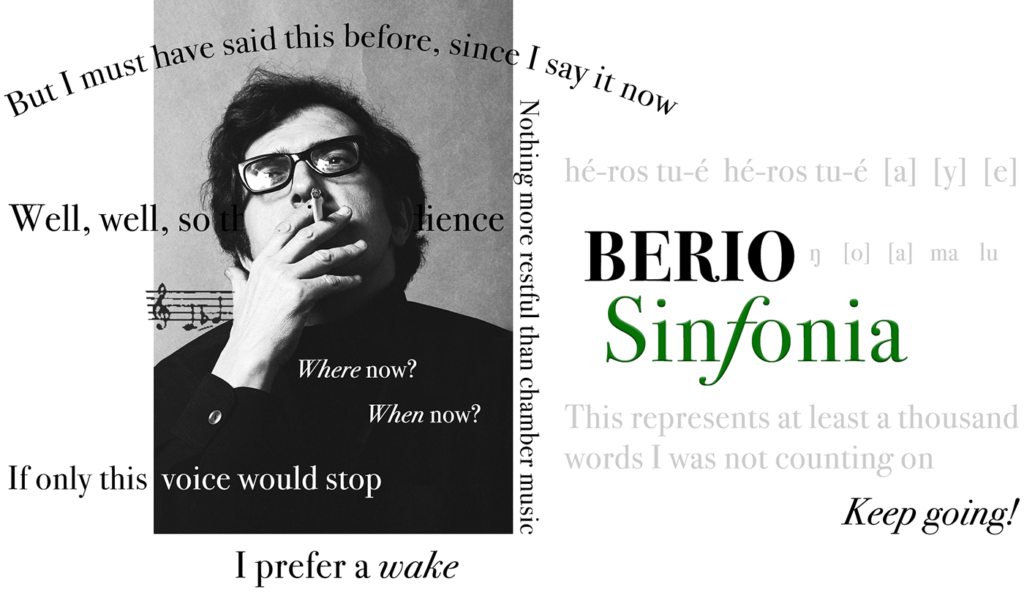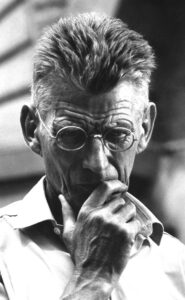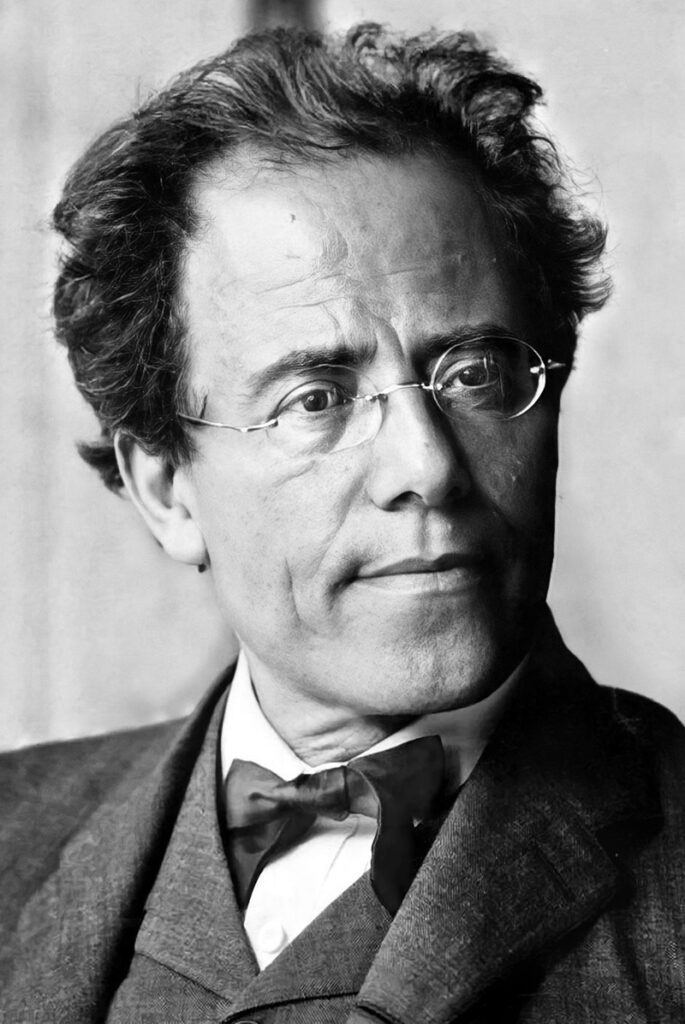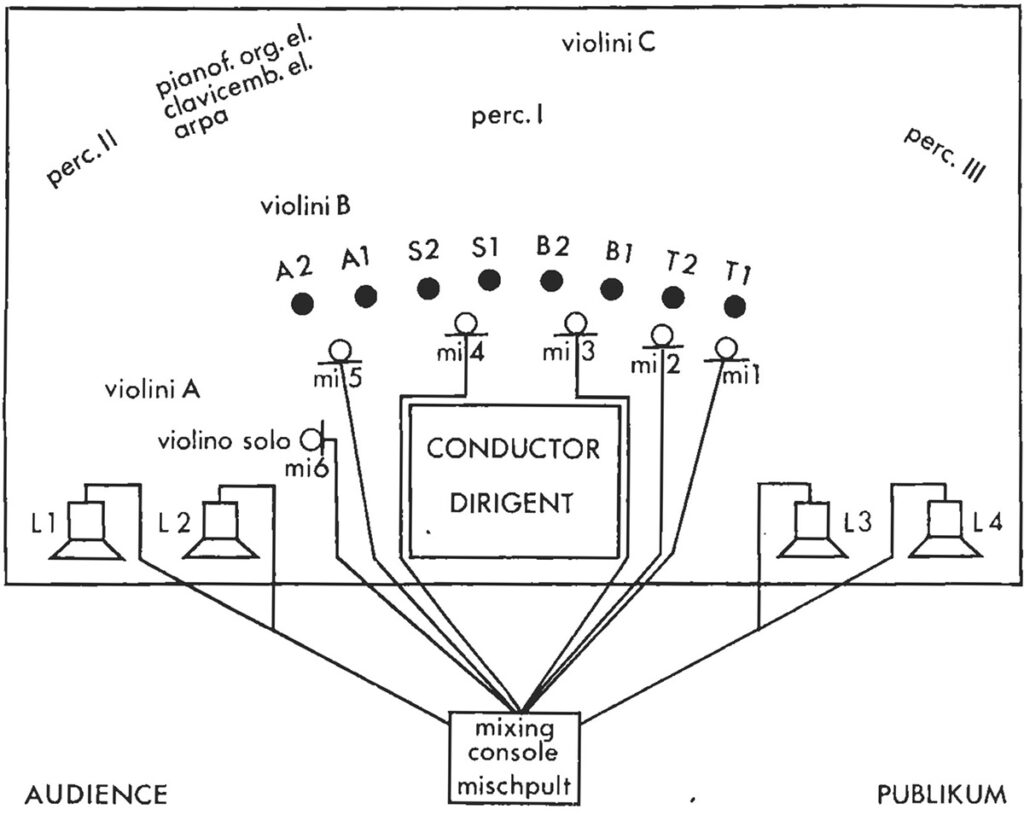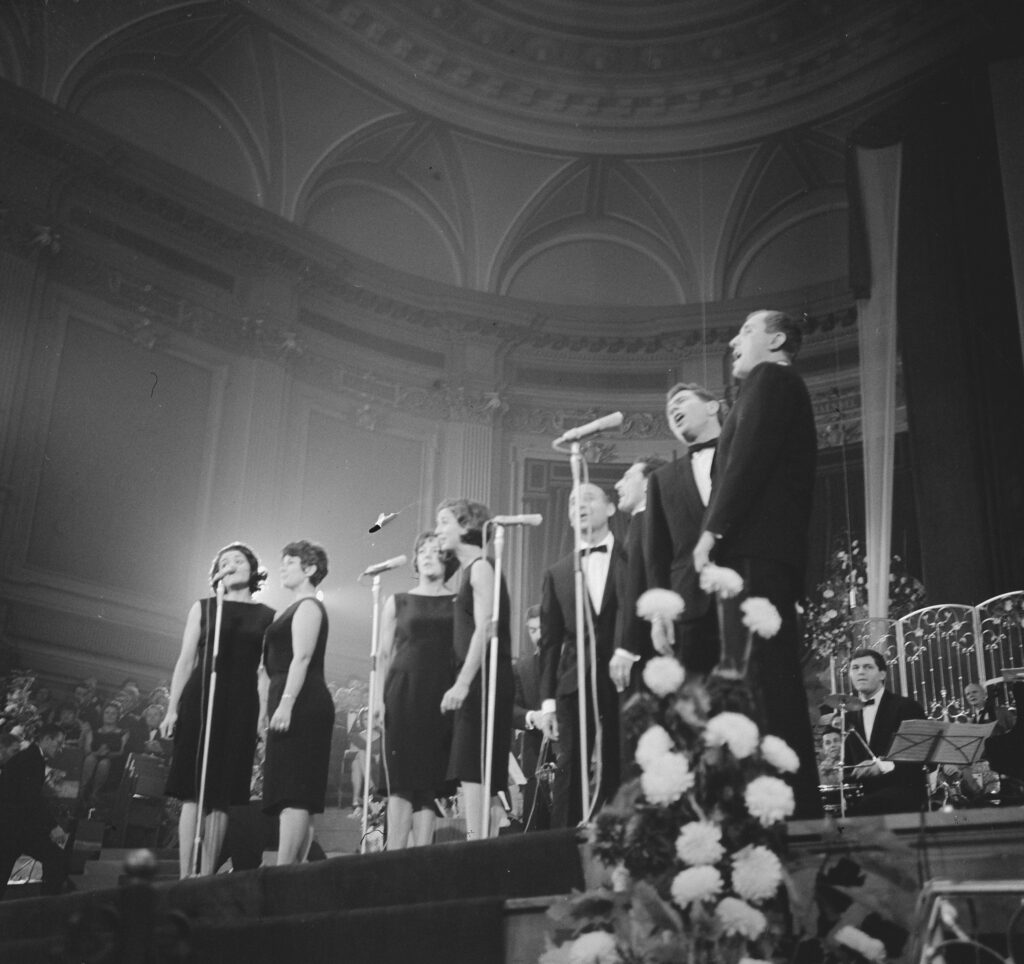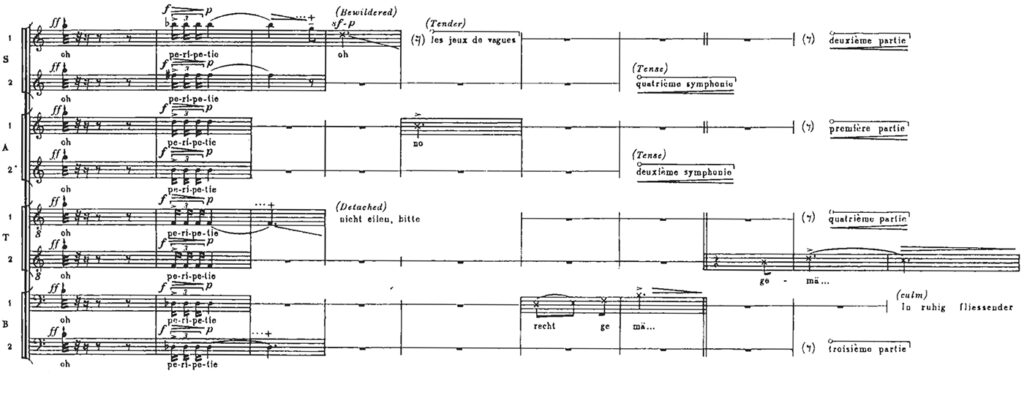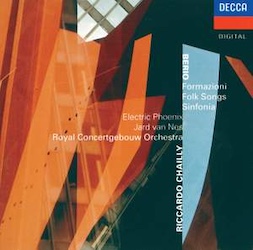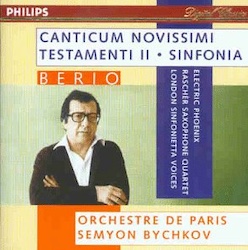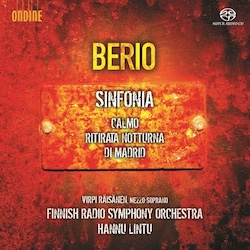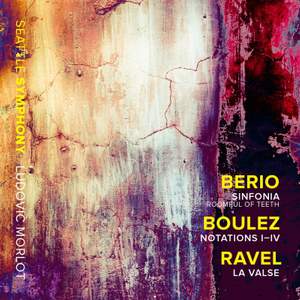Joyce Music – Berio: Sinfonia
- At September 04, 2023
- By Great Quail
- In Joyce
 0
0
But now it’s done, it’s over, we’ve had our chance. There was even, for a second, hope of resurrection… We must collect our thoughts, for the unexpected is always upon us, in our rooms, in the street, at the door, on a stage. Thank you, Mr. Berio.
—“Sinfonia,” 1968
Sinfonia
(1968-1969)
I. —
II. O King
III. In ruhig fließender Bewegung
IV. —
V. —
Sinfonia stands as Berio’s greatest achievement, one of the few pieces of mid-century music to become part of the canon, given numerous performances around the world and beloved by audiences and musicians alike. At least eight commercial recordings have been made of Sinfonia, something you can’t say about Boulez’ Pli selon pli or Stockhausen’s Gruppen. Indeed, interest in Sinfonia goes beyond enthusiasts of “classical” music. Berio’s use of texts by Claude Lévi-Strauss and Samuel Beckett gives Sinfonia a particular literary appeal, and the way he incorporates these texts, along with his ingenious use of musical quotation, have made Sinfonia a popular subject of study by postmodern critics and theorists. And most relevant to this page, Sinfonia remains an object of fascination for Joyceans. Sinfonia is frequently compared to Ulysses or Finnegans Wake, and a small photograph of Joyce adorns the sleeve of the original 1969 Columbia LP.
Before I explain why Sinfonia interests Joyceans, let me offer one of those “full disclosure” statements—Sinfonia is one of my favorite pieces of twentieth-century music. I first heard Sinfonia in 1998. Robert Spano was conducting the Brooklyn Philharmonic, an ambitious program called the “ABC” concert: John Adams’s Harmonielehre, Luciano Berio’s Sinfonia, and Elliot Carter’s Allegro Scorrevole. I say “I first heard” Sinfonia, but this is an exaggeration: I had previously listened to Sinfonia on CD, specifically the 1986 Erato recording conducted by Pierre Boulez. But casually listening to a CD and hearing a piece of music performed live are two very different experiences, and what I heard that night was a revelation.
I was fairly immersed in Ulysses at the time, participating in a group-reading with some Joycean first-timers and expanding the music sections of the Brazen Head. And that night at BAM I heard a piece that reminded me so thoroughly of Ulysses, I was astonished to find it was instead modeled on Beckett’s The Unnamable. Never mind, I thought, irrelevant; Sinfonia was more “Joycean” than any of Berio’s compositions directly inspired by Joyce—Chamber Music, Epifanie, even Thema (Omaggio a Joyce) didn’t compare. Sinfonia didn’t need to quote from Ulysses, it was the musical equivalent of Ulysses—a work of artistic genius that embraced tradition and exploded it, a multi-layered masterpiece that combined numerous styles, correspondences, and themes into something wonderfully new. Complex, yes; but a pleasurable complexity. There’s an excitement, a joy to hearing Sinfonia that compares to reading “Sirens,” “Cyclops,” or “Oxen of the Sun”—a state of amazement mingled with moments of confusion and flashes of recognition.
Approaching Sinfonia
I’ve put in so many enigmas and puzzles that it will keep the professors busy for centuries arguing over what I meant, and that’s the only way of insuring one’s immortality.
—James Joyce on “Ulysses”
While Ulysses can be thoroughly enjoyed “going in cold,” first-time readers are often advised to do a little homework before taking the plunge. It certainly helps to understand the book’s relationship with Homer’s Odyssey, but it doesn’t hurt to review Hamlet and read Yeats’ short poem, “Who Goes with Fergus?” Laying this groundwork ensures a deeper understanding of the text. It brings a reader further inside the work and creates more meaningful connections.
The same can be said about Sinfonia. Granted, one’s time investment is less intense—Sinfonia is only 35 minutes long, after all. But it’s dense, a postmodern puzzle-box layered with quotations, allusions, jokes, and correspondences. And just as Joyce leans on Homer for Ulysses and Vico for Finnegans Wake, Berio constructs Sinfonia around load-bearing structures that support its dazzling complexity. Two of these are literary and one is musical. Understanding this trio of mythes de reférénce—to borrow a term from Lévi-Strauss—opens the door to a deeper appreciation of the piece.
Le cru et le cuit, by Claude Lévi-Strauss
Translated as The Raw and the Cooked, this is the first book of Mythologiques, a four-volume study of indigenous belief systems by the French anthropologist Claude Lévi-Strauss. Like Luciano Berio and Umberto Eco, Lévi-Strauss was influenced by the Swiss linguist Ferdinand de Saussure, one of the founders of semiotics. In Le cru et le cuit he applies de Saussure’s theories of “binary oppositions” to the creation myths of the Bororo, an indigenous people from the Mato Grosso region of Brazil. His analysis is characteristically idiosyncratic, tracing Bororo customs and social structures through a complex system of belief involving contrasting elements of fire and water. At the core of this mythology—and subsequent social and linguistic development—Lévi-Strauss finds an innate opposition between “sensory” binaries: water and fire, life and death, the “raw and the cooked.” This latter opposition is extended to culture in general, where the “raw” is seen as natural and primitive, and the “cooked” as artificial and civilized.
The Unnamable, by Samuel Beckett
Published in 1953, The Unnamable is the third book in Samuel Beckett’s existential “Trilogy.” The novel consists of a nameless narrator, talking himself into existence and staying afloat solely through the act of expression. This mysterious “protagonist” has no body or location, claims to be the author of Beckett’s previous works, and is haunted by figures such as Mahood and Worm, who may or may not be projections of himself. The reader soon intuits this protagonist to be Beckett’s narrative voice, alive insofar as it exists in the intangible nexus between author, page, and reader. Positioned at the pivot between Modernism and postmodernism, The Unnamable calls to question the act of creation itself, and represents an important precursor to the trope of the self-aware narrative.
Symphony No. 2, “Resurrection,” by Gustav Mahler
First performed in 1895, Gustav Mahler’s towering “Resurrection” Symphony is a 90-minute work divided into five movements. As its name indicates, the symphony is about death and rebirth. It begins with a majestic funeral march, followed by a long and solemn pause. The leisurely second movement reflects on the life of the deceased. The third movement is the most important to Berio’s Sinfonia, and demands a more detailed explanation.
A prolonged scherzo entitled “In ruhig fließender Bewegung” (“In a calm, flowing movement”), the movement is based on the German poem “Des Antonius von Padua Fischpredigt” from Des Knaben Wunderhorn. (“St. Anthony of Padua Preaches to the Fishes,” from The Boy’s Magic Horn.) According to Catholic lore, after being ignored by the townsfolk of Rimini, St. Anthony began preaching to the fish of the Marecchia River. The fish gathered in orderly schools to attend his sermon. Seeing this miracle, the people of Rimini repented their rudeness. The Wunderhorn poem takes a more satirical view. After unanimously agreeing that no sermon has ever pleased them so, the fish return to their wicked ways, the sermon immediately forgotten! In his original program notes, Mahler explained that his scherzo reflected the “meaningless activity” of life, filled with “senseless agitation” and concluding with a “death shriek.” In a later remark, he suggested that Saint Anthony might have indulged in a little too much wine before his fishy sermon; an insinuation written into the looping scherzo itself.
The fourth movement of “Resurrection” is also inspired by Des Knaben Wunderhorn, a setting of the song “Urlicht” for alto. The fifth movement is the longest and most complex. It begins with the “death shriek” from the scherzo, incorporates material from previous movements, and features a choral setting of Friedrich Gottlieb Klopstock’s Die Auferstehung (“The Resurrection”) combined with Mahler’s own verses about redemption. Keep this in mind as we return to Berio!
Back to Berio
The original Sinfonia contained four movements loosely connected by themes of water and death. It was scored for a large orchestra with several percussionists, an electronic organ, an electric harpsichord, a third row of strings in the back, and eight amplified singers: two sopranos, two altos, two tenors, and two basses. Dedicated to the great Mahler interpreter Leonard Bernstein, Sinfonia premièred on 10 October 1968 at the Philharmonic Hall in New York City. Berio conducted the New York Philharmonic, and the Swingle Singers formed the octet. The following year Berio added a fifth movement, one that recapitulated and settled the material of the first four. This final version premièred at Donaueschingen on 18 October 1969, again with the Swingle Singers.
I.—
The first movement of Sinfonia is untitled. It begins in a hush of mystery, born from a blurry trio of gongs. Eight voices emerge harmonizing from the silence, suddenly breaking free in a flurry of muttered syllables and fragments of text derived from Claude Lévi-Strauss’ Le cru et le cuit. The subject of this labyrinthine movement is the Bororo “origin story” of rain, which involves the theft of three musical instruments and brothers who raped their own mother. This myth is linked to the creation of rivers and lakes, then compared to similar stories from neighboring peoples. Water myths are contrasted to fire myths, which leads to a series of oppositions between fire and water, water and earth, and earth and heaven.
Or at least, that’s the original meaning of the text—one would never gather this from Berio’s “setting!” Sinfonia continues the vocal experiments he began with Thema, Sequenza III, and Laborintus II. He treats Lévi-Strauss’ text as raw material, dismembering sentences and shuffling the fragments to form novel correspondences between meaning and sound. Key words are further atomized into syllables, vowels, and consonants. Stripped of essential meaning, these phonemes are deployed for purely sonic effect. Some are even “sung” through closed lips.
Although he would later come to appreciate Sinfonia, Lévi-Strauss’ initial response was bafflement. As an interviewer reported, “if Berio’s Sinfonia uses passages from Le cru et le cuit, our author has the impression that his text was picked up by chance; that he has nothing to do with the work!” Here and there segments of the original text remain intact, but their meaning is obscured to all but the most informed listener:
The narrator starts his story…impeded by a curious semantic stutter that hints at fragmentation to come, but is almost immediately interrupted by a taboo-imposing orchestra just as he is about to recount the group rape of a mother by her sons. (David Osmond-Smith, Playing on Words)
The orchestra becomes increasingly aggressive as the movement continues. The star is a frantic piano, hounded by skeletons of pitched percussion and forced to navigate thorny clusters of reeds and explosions of brass—the last two minutes sound like a “Quaderni” from Epifanie violating a piano concerto. There’s more playful touches too, such as eight muted horns that echo the vocalists, a ghost of the octet impressed into the protean surge of the score. Just as the scampering piano escapes the cat’s-paws of the orchestra, the tam-tams return to silence the movement.
II. O King
The second movement is titled “O King.” Originally written for a mezzo-soprano and small ensemble in 1967, this tribute to Martin Luther King was expanded to eight voices for inclusion in Sinfonia. The piece dissolves King’s name in a cloud of phonemes, each given IPA designations and mapped on a rotating series of pitch cycles anchored in F and A, with a different selection of notes sustained each cycle. This creates an eerie harmonic cloud, oscillating between two whole-tone areas—a haze of unsettling music in search of resolution. Occasionally the haze is punctured by needles of brass or sustained notes from the piano, which has its pedals depressed for the duration of the movement. As “O King” circles towards its conclusion, the voices finally articulate the phonemes in the correct order. The name “Martin Luther King” materializes from the cloud, a pointillist image coming into focus. A stuttering snare drum arrives to disperse the movement. The intrusion of this martial instrument carries an echo of violence, a reminder of turmoil and martyrdom.
III. In ruhig fließender Bewegung
The third movement of Sinfonia is Berio’s most famous and celebrated composition. A tour de force of musical ingenuity, the movement careens through twelve exhilarating minutes like a roller-coaster: always threatening to fly off the rails or collapse under its own weight, but unerringly returning the audience safe and sound. And like any good thrill ride, the secret to its success lies in careful engineering.
As its name suggests, “In ruhig fließender Bewegung” is constructed upon the swinging scherzo of Mahler’s “Resurrection” Symphony. And while Mahler lays the rails, Berio provides the dips, twists, and curves, elaborating this structure with dozens of musical quotations from Beethoven to Boulez. These allusions are not simply welded to an already-overburdened framework—Berio alloys them into the Mahlerian structure itself, adding and subtracting elements to produce a coherent whole. The effect is like hearing individual personalities pass through a chattering crowd without disrupting the flow. Here some instruments allude to Stockhausen; over there another group gives voice to Stravinsky; meanwhile a rogue soloist is playing Hindemith. Ravel, Schönberg, even Berio himself have their say; but Mahler always returns—even when obscured, masked, or obliterated, the Mahler returns, often without missing a beat. David Osmond-Smith uses the wonderful phrase “incremental obliteration” to describe Berio’s technique:
For if Berio had sought to generate layers of commentary from the Mahler text itself he would have had to subject it to extensive transformation. If instead he had relied entirely upon his own harmonic vocabulary the gap between text and commentary would have been too great. So he opted for materials that establish a wide harmonic range—many of them quotations from other composers’ work. Thus against Mahler’s predominant diatonicism are set the more sumptuous harmonies of Ravel, Strauss and Debussy, the atonality of the second Viennese school, and massive, chromatically saturated orchestral clusters. Merely to superpose these leaving the original intact, as in the previous movement, would clearly make for a cloying density of texture—as well as demanding gargantuan forces. Berio therefore blocked out ever greater amounts of the original material, at first so as to provide room for the various commentary materials, but later as an autonomous process that leaves only a skeleton of Mahlerian fragments. It is this incremental obliteration that provides the large-scale shape of the movement. (David Osmond-Smith, Playing on Words)
Berio himself compared Mahler’s scherzo to a river running through Sinfonia:
If I were asked to explain the presence of Mahler’s scherzo in Sinfonia, the image that would naturally spring to mind would be that of a river running through a constantly changing landscape, disappearing from time to time underground, only to emerge later totally transformed. Its course is at times perfectly apparent, at others hard to perceive, sometimes it takes on a totally recognizable form, at others it is made up of a multitude of tiny details lost in the surrounding forest of musical presences.
It’s an apt description, calling to mind Mahler’s original inspiration from Wunderhorn. (Joyceans may also hear echoes of Anna Livia Plurabelle: “riverrun, past Eve and Adam’s, from swerve of shore to bend of bay, brings us by a commodius vicus of recirculation back to Howth Castle and Environs.”) Other water allusions flow into Mahler’s river like tributaries springing from the rainy headwaters of the first movement: Debussy’s La Mer, Beethoven’s Sixth Symphony, the drowning scene from Berg’s Wozzeck, and the fourth movement of Schönberg’s opus 16, inspired by a “summer morning at a lake.”
One could continue discussing Berio’s innovative use of the orchestra, but what most people remember about Sinfonia are its vocal gymnastics. Berio’s use of the amplified octet in the third movement is legendary, and it’s the main reason classical enthusiasts still speak fondly of the Swingle Singers—sure, their Bach stuff was more popular at the time, but it’s their association with Sinfonia that’s secured their place in musical history.
Just as Mahler gave structure to the movement’s orchestral complexities, Beckett provides a template for the libretto, the self-aware monologue from The Unnamable splintered into a myriad of voices and modalities. Like Beckett’s tortured narrator, the octet is never silent, willing itself into being with real-time commentary on Berio’s unfolding score. This commentary is interspersed with classical music clichés, parodistic reviews, snippets of related songs, contemporary radical slogans, Yuletide solfège, gobbles and grunts, and perhaps most striking of all, the insistent command to “Keep going!” (Most of these vocals are paired with Berio’s instructions on delivery, a list of parenthetical one-word descriptions ranging from “detached” to “desperate.”) There’s constant interplay between the voices and the instruments, a “sounding together” of bickering dialogue, harmonious agreement, and ironic counterpoint.
This sense of play is evident from the very beginning. The orchestra explodes to life, trumpets and trombones blasting the Mahler with a chord derived from early Schönberg. Although played in a different rhythm, these same notes begin “Peripetie,” the fourth movement of Five Orchestral Pieces, Op. 16. The octet enters the third movement in harmony, recognizing the Schönberg chord by name—“oh pe-ri-pe-tie.” As Riccardo Chailly has suggested, this “maniac chord” links Mahler to Schönberg, the passing of a musical torch from fin du siècle Vienna to the Second Viennese School of serialism. But there’s a subtle textual allusion as well. Peripetie is the German word for “peripeteia,” a sudden reversal of fortune. The equivalent French word péripétie appears twice in Le cru et le cuit. Near the end of the fifth movement, the octet will unify again over the French word, singing “pé-ri-pé-tie” just before delivering Sinfonia’s closing line. The act connects the beginning of the third movement with the end of the fifth, transforming one type of quotation into another—Schönberg’s chord becomes a “note” from Lévi-Strauss.
But for now, let’s return to the beginning of the third movement. As soon as this opening chord resounds, different instruments begin playing different fragments of music: the second movement of Debussy’s La Mer, the fourth movement of Mahler’s Fourth Symphony, and of course, the third movement of Mahler’s “Resurrection.” (As musicologist Paul Griffiths has pointed out, all are rhythmically and harmonically related, seamlessly fused together by Berio’s compositional alchemy.) The first soprano moves from a “bewildered” exclamation to “tender” acknowledgment of Debussy’s “les juex des vagues.” The second soprano argues “tensely” with the first alto over just which Mahler symphony is being played—“quatrième symphonie”… “deuxième symphonie.” As the orchestra coalesces into the “Resurrection” theme, the first bass announces, “In ruhig fließender Bewegung.” Delighted to have reached consensus, the octet rewards the orchestra by chanting the melody in cheerful solfège.
Meanwhile, a violin takes up the frantic fifth movement of Hindemith’s Kammermusik Nr. 4, which prompts the first tenor to “tenderly” remark, “Nothing more restful than chamber music,” Berio’s rewriting of Beckett’s “Nothing more restful than arithmetic.” This substitution also functions as a musical in-joke, referring to Hindemith’s highly-systematic compositional style, not to mention the precise restlessness of Hindemith’s “chamber music.”
And this is just the first 30 seconds! This kind of complex interplay continues throughout the movement; one could randomly select any 30-second segment and unravel a dozen allusions and correspondences. Because this page focuses on the Joycean nature of Sinfonia, one more example will suffice.
Early in the third movement, the orchestra banters between Hindemith’s Kammermusik and Berlioz’s Symphony Fantastique. While the first alto complains about an ostinato—“It seems there are only repeated sounds”—the second bass scolds the orchestra for playing Hindemith: “No time for chamber music!” The first tenor “condescendingly” agrees, archly dismissing Berio’s academic pretentions: “You are nothing but an academic exercise.” He then adds, “I prefer a wake.” While Osmond-Smith remarks this is “clearly a Joycean reference, though it’s source has not yet been traced,” I think it’s more in the style of an in-joke than a direct quotation. Chamber Music is one of James Joyce’s earliest works, a collection of poems celebrated for their musicality and stylistic simplicity. Berio set three of these poems to music in Chamber Music, one of his earliest pieces dating from 1953. Since setting these poems, he was introduced to Joyce’s more mature works, and developed a lasting fascination with Ulysses and Finnegans Wake. Clearly the first tenor is making a humorous allusion to Berio’s own relationship with Joyce, moving from the relative simplicity of Chamber Music to the Wakean complexities of Sinfonia?
Another aspect of Ulysses and Finnegans Wake shared by Sinfonia is the work’s self-awareness, a postmodern trope programmed into the Beckettian monologue. At some point during the third movement, Sinfonia surges into a kind of sardonic self-awareness, largely expressed by the ubiquitous first tenor. As his consciousness peeps from the score to inspect the concert hall, he begins to understand “how it is”:
well well, so there is an audience, it’s a public show, you buy your seat and you wait, perhaps it’s free, a free show, you take your seat and you wait for it to begin, or perhaps it’s compulsory, a compulsory show . . . you wait for the compulsory show to begin, it takes time, you hear a voice, perhaps it is a recitation, that is the show, someone reciting, selected passages, old favourites, or someone improvising . . . every now and then a familiar passacaglia filters through the other noises waiting, for something to begin, for there to be something else but you…
As usual with Berio, humor and irony are used to leaven more serious themes, and Sinfonia asks some of the same questions posed by his overtly political works such as Passaggio, Coro, La vera storia, and Outis—What use is art in a world riven by conflict and impoverished by hunger? As the movement nears its conclusion, the first tenor becomes “desperate,” his voice a blend of Beckett and Berio’s own:
For when we find ourselves, face to face, now, here, and they remind us all this can’t stop the wars, can’t make the old younger or lower the price of bread—[First alto: Say it again, louder!]—it can’t stop the wars, can’t make the old younger or lower the price of bread, can’t erase solitude or dull the tread outside the door, we can only nod, yes, it’s true, but no need to remind, to point, for it is all with us, always, except, perhaps at certain moments, here among these rows of balconies, in a crowd or out of it, perhaps waiting to enter, watching. And tomorrow we’ll read that [*mentions composer and title of a work included in the same program] made tulips grow in my garden and altered the flow of the ocean currents. We must believe it’s true. There must be something else. Otherwise it would be quite hopeless. But it is quite hopeless. Unquestioning. But it can’t go on. It, say it, not knowing what. It’s getting late.
The tenor finally introduces the rest of the singers and thanks the conductor by name, bringing the roller-coaster scherzo to an end.
But now it’s done, it’s over, we’ve had our chance. There was even, for a second, hope of resurrection… We must collect our thoughts, for the unexpected is always upon us, in our rooms, in the street, at the door, on a stage. Thank you, Mr. [*full name of the conductor]
The safety bar lifts up, and the dazed audience files into the next movement.
IV.—
The fourth movement begins with a clever feint: the octet sings the first two notes of “Urlicht,” the song that follows the scherzo in Mahler’s “Resurrection” Symphony. Well, not quite the entire octet; the first bass makes “random sounds simulating fast speech,” a whispered muttering scored as IPA symbols. Berio uses Mahler’s notes to develop a sequence of 12-note chords, each constructed through the gradual accretion of voices and instruments. For the most part, the singers focus on a single phrase drawn from Lévi-Strauss: “Rose de sang,” or “rose of blood.” A dark mirror to the opening lines of “Urlicht”—“O Röschen rot,” or “O red rose”—this phrase is broken into elongated syllables and voiced at different rates across four distinct cycles. As this meditation unfolds, the “whispered muttering” is passed between the eight voices, a hushed continuo like a confession drifting from a distant alcove. Berio’s instrumentation is minimal: muted horns, trembling strings, flutter-tongued flutes joining the singers as each chord achieves chromatic saturation. After the giddy scherzo of the third movement, the restraint and elegance of this brief interlude feels tranquil despite the macabre lyric.
V.—
Even before its New York première, Berio believed Sinfonia was incomplete. The fourth movement was an extension of its ideas, not a closing argument. Becoming “convinced of its necessity” after the première, Berio composed the fifth movement three months later. Reaching back to nineteenth-century notions of recapitulation and closure, Berio constructed the final movement to serve as an analysis and synthesis of the previous four. As he remarked in a 1980 interview, the fifth movement “is by far the most complex because it takes up, transforms and comments on all the others. The first four parts of Sinfonia are to the fifth as Mahler’s scherzo is to the third.”
The fifth movement begins with the piano from the first movement, angrily reasserting itself some twenty minutes after being so rudely interrupted. The first soprano joins, developing the Lévi-Strauss quotation that dominated the fourth movement: “rose de sang, appel bruyant, doux appel,” or “blood rose, loud call, soft call.” Although her entrance is accompanied by a flute, she sings “as if estranged” from both instruments. Before one imagines this movement may continue as a delicate recital for soprano, piano, and flute, a spike of brass from the tuba announces the arrival of the orchestra and the remainder of the octet. Instruments and voices pile upon each other in chaotic proliferation: snatches of Hindemith, echoes of Mahler, bickering “water” and “fire” elements from the first movement. This brief salvo collapses in a flurry of vowels, whispered consonants, and flute trills playfully mocked by the sopranos.
Order is re-established through the adoption of the rotating pitch cycles from “O King,” used here to generate new clouds of shifting harmonies. The singers alternate between syllables, phonemes, and spoken quotations drawn from Lévi-Strauss. For the first time in Sinfonia, these quotations are intelligible, even if they frequently overlap. For those worried that Berio has gone soft on ol’ Claude, he still has another trick up his sleeve. As Osmond-Smith has noted, Berio alters these quotations much the same way he changed Beckett’s, tailoring them to fit the theme of music, and Sinfonia in particular:
Partout, ailleurs, les themes inversent la valeur de leur termes selon qu’il s’agit de retarder la mort ou d’assurer la resurrection (Everywhere, elsewhere, the themes reverse the value of their terms, depending on whether it is a question of delaying death or ensuring the resurrection.)
The music from the third movement is reduced to quotations tumbled from the orchestra like fragments of a bygone dream, a Joycean “fadograph of a yestern scene.” There’s Berio and Mahler, of course, but also Hindemith, Debussy, and Stravinsky. These quotations are frequently distorted or transposed to appear vague—echoes and ghosts. Indeed, much of this movement seems genially haunted, a carnival funhouse filled with jump-scares and distorted mirrors. As Berio remarked, “The memory is constantly stimulated and put to work, only to be contradicted and frustrated.” Occasionally the second tenor recalls his previous life from the third movement, shaking off his new role as French anthropologist and entreating the audience in plaintive English: “Listen, listen: are you going already? Listen, listen, let me see your face once more.”
The tenor’s wistful nostalgia is ignored by the bulk of the orchestra, which becomes more dynamic as the pitch cycles near completion, tossing spirals of sound from one cluster to the next. There’s a sense of gathering momentum, the orchestra winding itself up to a crescendo. At one point the musicians are parodied by the vocalists, who imitate the whirling instruments like excited fans scatting along to dramatic passages. As the brass becomes more insistent, rattling snare drums drive the movement to a protracted, fractured climax. The octet virtually disintegrates, their voices merging with the orchestra in an explosion of words and music.
Now spent, the forces disperse. The octet momentarily regroups on “péripétie,” then dissolves into a series of staggered syllables, the final phrase of Sinfonia rendered incomprehensible by the overlapping rhythms: “héros tué,” or “hero slain.” (O King?) The voices reunify on the last syllable, then relax into their opening pitches, recreating the harmony that ushered in the first movement. With the same hushed gongs that began the work, Sinfonia melts back into the silence from whence it came.
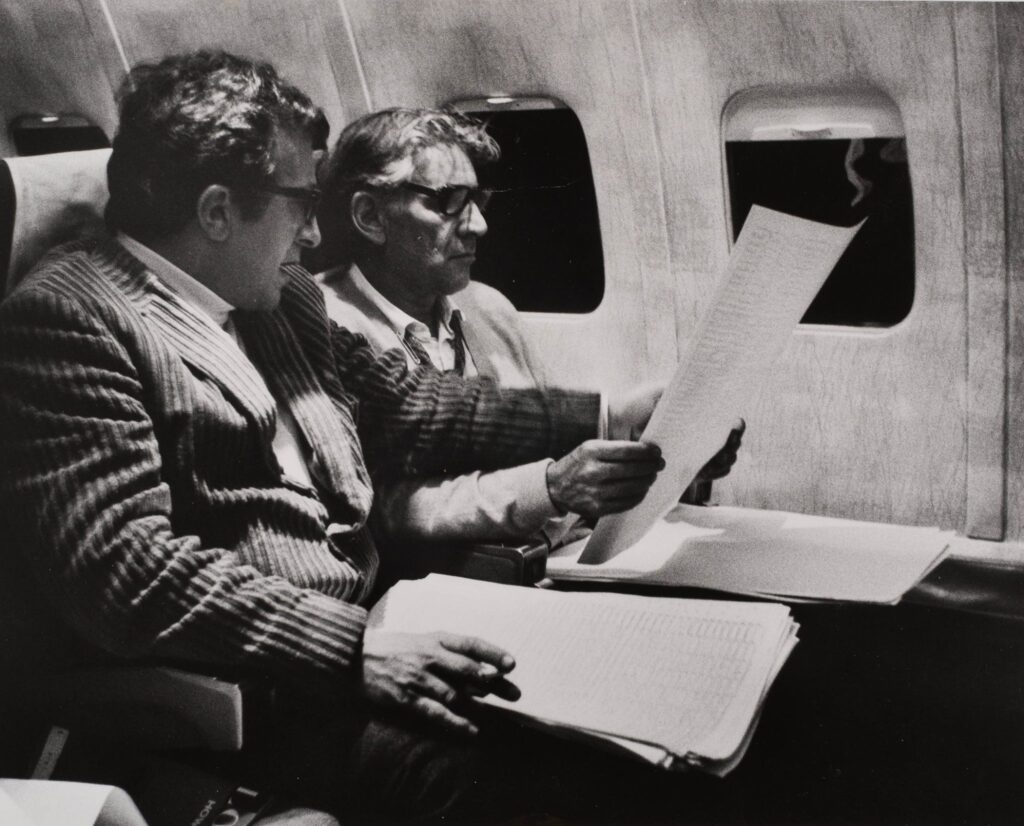 Berio and Bernstein look over “Sinfonia,” 1968. From NYPhil Archives.
Berio and Bernstein look over “Sinfonia,” 1968. From NYPhil Archives.
Sources and Notes
Books, they talk to each other. Musics, from different ages, from different cultures, they talk to each other. Voices have their own history, and instruments too. So it’s nice when you can have the histories talk to each other, to comment on each other.
—Luciano Berio, “Voyage to Cythera,” 1999
One last similarity between Sinfonia and Ulysses is the sheer number of papers and books written to explicate each work! Although I consulted many of these while researching this piece, the one that stands out is David Osmond-Smith’s Playing On Words: A Guide to Luciano Berio’s Sinfonia. Osmond-Smith’s study remains definitive, and is frequently referenced in other papers, essays, and articles about Sinfonia. (Berio himself mentions it on several occasions.) Osmond-Smith’s Oxford Studies of Composers: Berio was also useful, as was Berio’s own Two Interviews, Paul Griffiths’ Modern Music and After, and Murat Eyüboglu’s paper, “Davies, Berio, and Ulysses.” For a complete bibliography of sources used for this page, see the Brazen Head’s Luciano Berio page.
Sinfonia: Liner Notes, Essays & Interviews
This Sinfonia page is the Brazen Head’s longest feature about a single musical work. To make things more manageable, I located the usual liner notes, essays, and interview excerpts to a separate page. These include Berio’s own comments, and Joycean analysis by Roger Marsh and Murat Eyüboglu.
Recordings
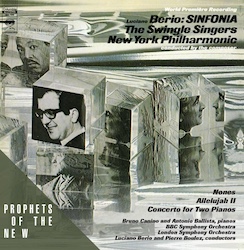 |
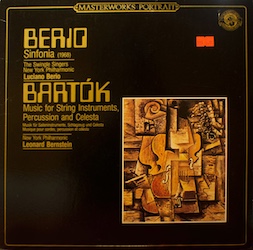 |
Berio: Sinfonia (1969)
Conductor: Luciano Berio
Musicians: New York Philharmonic
Vocalists: Swingle Singers
LP: Sinfonia. Columbia Masterworks MS 7268 (1969)
LP: Berio: Sinfonia; Bartók: Music for String Instruments, Percussion and Celesta. CBS 60259 (1983)
CD: Sinfonia. Sony 88765499922 (2013)
Purchase: CD [Amazon], Digital [Presto Music]
Online: YouTube [Movement III]
The first LP of Sinfonia was recorded live at the Philharmonic Hall in New York City on 12 October 1968, with Luciano Berio conducting the New York Philharmonic and the Swingle Singers. This four-movement première was released a year later on Columbia Masterworks. (The French version featured a particle accelerator on the cover!) In 1983 the recording was remastered and paired with Bartók’s unsettling Music for Strings, Percussion and Celesta by CBS Masterworks. This LP has since been deleted.
The most “current” version is the 2013 Sony “Prophets of the New” CD, which includes Berio’s Nones, Allelujah II, and Concerto for Two Pianos. The booklet replicates the original album sleeve. A photo of Luciano Berio graces the front cover, along with Sinfonia dedicatee Leonard Bernstein, Martin Luther King, and some bearded fellow I don’t recognize. The back cover sports images of Gustav Mahler, Beethoven, James Joyce, and Samuel Beckett. I have no idea why Claude Lévi-Strauss wasn’t invited to the party!
This is my favorite “historical” recording of Sinfonia, despite having no fifth movement. It’s the most visceral and immediate of the recordings, and the Swingle Singers sing like they’re discovering the music for the first time—which, I suppose they are.
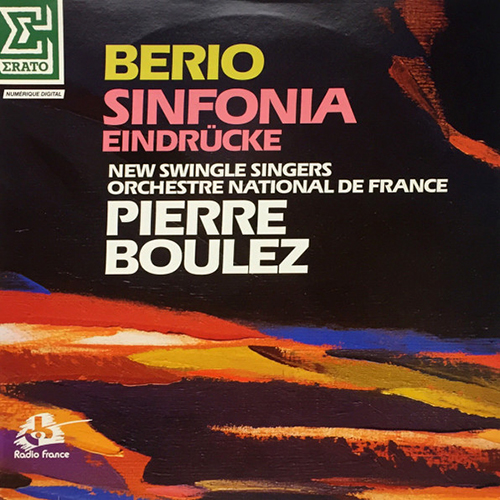 |
 |
Berio: Sinfonia (1986)
Conductor: Pierre Boulez
Musicians: Orchestre National de France
Vocalists: New Swingle Singers
LP: Sinfonia & Eindrücke. Erato NUM 75198 (1986)
CD: Sinfonia & Eindrücke. Erato ECD 88151 (1986)
Reissue CD: Sinfonia & Eindrücke. Apex 8573 B9226 2 (2001)
Purchase: CD [Amazon]
Online: YouTube
First released on Erato in 1986, this is the first recording of the complete 5-movement Sinfonia. It’s impeccably performed by the French National Radio Orchestra conducted by Pierre Boulez. More than any other recording, the first tenor is the star here, dominating the third movement like a narrator. Sinfonia is paired with Berio’s Eindrücke, a tense, revolving work that drives the orchestra in looping spasms, drawing inspiration from the rolling monody that ended Sinfonia. Sadly, the CD has been deleted, but you can still acquire used copies fairly easily.
Berio: Sinfonia (1990)
Conductor: Riccardo Chailly
Musicians: Royal Concertgebouw Orchestra
Vocalists: Electric Phoenix
CD: Berio: Formazioni, Folk Songs, Sinfonia. Decca/London 425-832-2 (1990)
Purchase: CD [Amazon], Digital [Presto Music]
Online: YouTube
Chailly’s Sinfonia is supported by Electric Phoenix, a vocal group founded by members of the Swingle Singers. It’s an excellent recording with sharp dynamics, and the orchestra plays with great vigor. The voices are well-mixed, and everyone seems to be having a lot of fun, particularly the first tenor, who comes across more excited than usual in the third movement. The liner notes are written by the composer Roger Marsh. The producer of Naxos’ James Joyce series, Marsh makes mention of Sinfonia’s Joycean parallels.
Berio: Sinfonia (1996)
Conductor: Semyon Bychkov
Musicians: Orchestre de Paris
Vocalists: Electric Phoenix
CD: Canticum Novissimi, Testament II, Sinfonia. Philips 446 094-2 (1996)
Purchase: CD [Amazon], Digital [Amazon]
A decent performance with Semyon Bychkov conducting the Orchestra de Paris. This is the second recording of Sinfonia from the 1990s featuring Electric Phoenix. The octet brings the same energy and humor they brought to Chailly’s recording; but here they’re occasionally muscled aside by the orchestra, which lacks the finesse of Chailly’s RCO. The production is also inferior, lacking the crispness and instrumental distinction of the Decca set. For those wishing to hear Sinfonia performed by Electric Phoenix, the Chailly recording is the better choice.
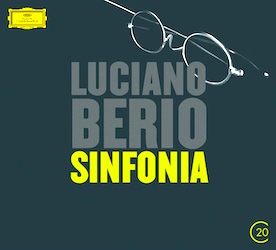 |
Berio: Sinfonia (2005)
Conductor: Peter Eötvös
Musicians: Göteborgs Symfoniker
Vocalists: London Voices
CD: Sinfonia & Ekphrasis. Deutsche Grammophon 0289 477 5380 3 GH (2005)
Reissue CD: Sinfonia. Deutsche Grammophon 002894790342 (2012)
Purchase: CD [Amazon (2005) | Amazon (2012)], Digital [Presto Music (2005) | Presto Music (2012)]
Online: YouTube
Conducted by the Transylvanian composer Peter Eötvös, this is a solid Sinfonia, but occasionally lacks panache.
Berio: Sinfonia (2014)
Conductor: Hannu Lintu
Musicians: Finnish Radio Symphony Orchestra
Vocalists: Finnish Radio Symphony Orchestra
SACD: Sinfonia, Calmo, Ritirata Notturna di Madrid. Ondine ODE 1227-5 (2014)
Purchase: SACD [Amazon], Digital [Presto Music]
Online: YouTube [Movement II. O King]
This version of Sinfonia is unique because it’s available on SACD, with crystal-clear sound, expanded dynamics, and a 5.0 channel soundstage. (Why no “5.1” subwoofer?) Sadly, that’s the only thing special about it. Hannu Lintu is a capable conductor, and the FRSO have shown they can really nail Sibelius and Mahler; but the vital third movement of Sinfonia is completely fluffed. Not only do the engineers fail to take advantage of the 5.0 sound, the octet is utterly overpowered by the orchestra. Even the principal tenor is indistinguishable, and vital lines are just…lost in the mix. The witty banter between the vocalists and orchestra is obscured, a fatal flaw that drains the movement of its usual excitement.
This sense of “flatness” is exacerbated by a general lack of style. When Sinfonia is played well, the orchestra has the capacity to surprise the listener with airy quotations, sudden shifts in dynamics and tempo, and bickering exchanges between instruments. Here, Sinfonia’s complexities are smoothed into one consistent texture—there’s little nuance or dash, reducing Berio’s dynamic masterpiece to “just another work in the repertoire.” Sure, the other movements sound fine—to be fair, “O King” sounds great—but when the main attraction is so disappointing, it’s hard to recover. Having said that, Sinfonia is well paired with Calmo, Berio’s homage to his friend Bruno Maderna. An under-recorded work, it’s beautifully sung by Virpi Räisänen, the orchestra playing with the power and subtlety they showed on “O King.”
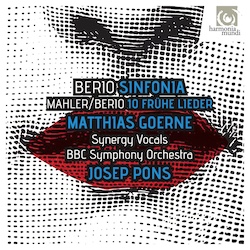
Berio: Sinfonia (2016)
Conductor: Josep Pons
Musicians: BBC Symphony Orchestra
Vocalists: The Synergy Vocals
CD: Berio: Sinfonia; Mahler/Berio: 10 Frühe Lieder. Harmonia Mundi HMC 902180 (2016)
Purchase: [Amazon], Digital [Presto Music]
Online: YouTube [Movement IV]
A truly excellent recording of Sinfonia from Joseph Pons, the BBC Symphony Orchestra, and Synergy Vocals, a group featuring former Swingle singers and closely associated with the works of Steve Reich. Of all the recordings of Sinfonia, this one features the vocalists most prominently, particularly on the celebrated third movement. Normally the first tenor is the star, but here the entire octet is placed at the front of the mix. Phrases usually lost in the musical scrimmage are crystal clear on this recording, and for once, the basses are nearly as intelligible as the sopranos. While some might find the vocalists too prominent, they rarely obscure the orchestra, which responds deftly to the complexities of Berio’s kaleidoscopic score. The characteristically bright horns of the BBC Symphony Orchestra are present in full force, but it’s the percussion that really shines, from the resonant timpani to the intricate textures of vibraphone, marimba, and glockenspiel—the “interrupted piano concerto” at the end of the first movement sounds surprisingly integrated. There’s also an appropriate use of electronic organ and electric harpsichord, something lost on most recordings after Boulez. The only weakness is the ethereal second movement, which fails to quite capture the otherworldly beauty of “O King.”
Berio: Sinfonia (2018)
Conductor: Ludovic Morlot
Musicians: Seattle Symphony
Vocalists: Roomful of Teeth
CD: Berio/Boulez/Ravel. Seattle Symphony Media SSM 1018 (2018)
Purchase: CD [Amazon], Digital [Presto Music] (Note: the 5.1 version advertised is only stereo)
Online: YouTube [Movement III]
With respect to the excellent Pons/BBC/Synergy set, this is my favorite “modern” recording of Sinfonia. Superbly conducted by Ludovic Morlot, the Seattle Symphony plays with energy and style, clearly excited by the challenge. To borrow a phrase from Pierre Boulez, they’re especially adept at conveying the “parentheses and italics” of Berio’s music, outlining the third movement’s allusions with delight, irony, and surprise. Like the 2016 BBC recording, Morlot fully embraces Sinfonia’s “very sixties” use of electronic organ and electric harpsichord. (What some later decades found dated and faintly embarrassing, modern audiences find charming!) The vocals are provided by Roomful of Teeth, who prove themselves worthy successors to the Swingle Singers and their many offshoots, singing with the same spirited vigor and creativity they bring to works by Caroline Shaw and Julia Wolfe. They’re also perfectly positioned in the mix: neither buried like the Lintu recording, nor placed directly in the ear like the Pons recording. The balance feels right, the closest to Berio’s original, and attentive to his instructions that the vocal group “should never overpower the orchestra.” (I also find it charming that the first tenor informalizes the libretto’s instructions by saying, “Thank you, Ludo” instead of “Thank you, Mr. Morlot.”)
Sinfonia is intelligently matched by two companion pieces—Boulez’s thorny Notations, and Ravel’s La Valse, itself a work extensively quoted in Sinfonia’s third movement. It’s just a shame that the recording is only available in stereo. A 5.1 surround-sound version was reportedly mixed, but remains unavailable even through the sources that advertise it. Hopefully this will be remedied in the future, and audiophiles will get to hear this wonderful recording in 24-bit surround sound!
Online Video
There are numerous versions of Sinfonia available on YouTube, including various excerpts and movements not listed here. I have not watched all of these performances, so they’re presented without commentary.
Sinfonia
Simon Rattle conducting the City of Birmingham Symphony Orchestra with Electric Phoenix
Recorded in 1987, this video features interviews with Berio and Sir Simon.
Sinfonia
Pierre Boulez Conducting the Chicago Symphony Orchestra and the Swingle Singers
Recorded live at Suntory Hall, Tokyo, 31 May 1995.
Sinfonia [Audio Only]
Luciano Berio conducting the Royal Concertgebouw Orchestra and the Swingle Singers
Recorded live 16 May 1997. Normally I wouldn’t list an audio-only recording, but this is Pierre Boulez and the Swingle Singers!
Sinfonia
Ed Spanjaard conducting the Royal Concertgebouw Orchestra and Synergy
Recorded live 10 December 2010 at the Concertgebouw Amsterdam.
Sinfonia
Rauf Abdullayev conducting the Azerbaijan State Symphonic Orchestra
Recorded live 2013-04-19 at the Qara Qarayev International Contemporary Music Festival in Baku, Azerbaijan.
Sinfonia
Christian Baldini conducting the UC Davis Orchestra
This video has no additional credits or annotations.
Sinfonia
Eduardo Leandro conducting Stony Brook Symphony Orchestra and Roomful of Teeth
Recorded at the Staller Center for the Arts, 29 October 2016.
Additional Information
Sinfonia: Liner Notes, Essays & Interviews
This Sinfonia page is the Brazen Head’s longest feature about a single musical work. To make things more manageable, I located the usual liner notes, essays, and interview excerpts to a separate page. These include Berio’s own comments, and Joycean analysis by Roger Marsh and Murat Eyüboglu.
Sinfonia Score
Berio’s score to Sinfonia is available as a PDF on this site.
Sinfonia Libretto
Pilgrimage to Parnassus has posted an easy-to-read version of Sinfonia’s “libretto,” for lack of a better word.
Voyage to Cythera
Filmed during rehearsals of Sinfonia at the Royal Concertgebouw in Amsterdam, Frank Scheffer’s 1999 documentary focuses on the eclectic third movement. It does a wonderful job of exploring Berio’s musical allusions, organically weaving them in and out of Sinfonia with surprising fluidity. The documentary features extensive English interviews with Luciano Berio and Riccardo Chailly, and Dutch interviews with composer Louis Andriessen. Unfortunately, the Dutch segments are not subtitled in English.
Repertoire: Berio’s Sinfonia—Still Astonishing
Dave Hurwitz discusses Sinfonia on his YouTube channel, “The Ultimate Classical Music Guide.”
Books and Papers
Playing On Words
David Osmond-Smith’s exhaustive analysis of Sinfonia is available through Amazon. It’s ridiculously expensive, but one can certainly find bootlegs PDFs floating around the Web!
“From Myth to Music: Levi-Strauss’s Mythologiques and Berio’s Sinfonia”
By David Osmond-Smith, Musical Quarterly, Vol. 67, No. 2, (Apr., 1981), pp. 230-260. Available as a PDF, this paper explores Sinfonia’s relationship to the works of Claude Lévi-Strauss. It was a precursor to Osmond-Smith’s larger monograph, Playing On Words.
“Berio’s Interpretation and Integration of Beckett’s The Unnamable in Sinfonia”
By Felix Constantin Goldbach and Ilia Bilbie Georgescu. International Journal of Mathematical Models and Methods In Applied Sciences, Issue 5, Volume 5, 2011.
Berio’s Main Sources
Mahler’s “Resurrection” Symphony
Conducted by Leonard Bernstein, naturally!
Le cru et le cuit | The Raw and the Cooked
Claude Lévi-Strauss’ book is available from the Internet Archive. [French | English]
The Unnamable
Beckett’s novel may be read at the Internet Archive.
Luciano Berio: Other Joyce-Related Works
Luciano Berio Main Page
Return to the Brazen Head’s Luciano Berio profile.
Chamber Music (1953)
Three songs adapted from Joyce’s poetry.
Thema (Omaggio a Joyce) (1958)
An electronic transformation of the opening text from the “Sirens” episode of Ulysses read by Cathy Berberian.
Epifanie (1961/65)
A variable sequence of orchestral and vocal pieces, including texts from A Portrait of the Artist as a Young Man and Ulysses.
Traces (1964)
Only given one performance and withdrawn, this “ghost opera” about racism was partially inspired by the “Circe” episode of Ulysses.
A-Ronne (1974/75)
A “documentary” on a poem by Edoardo Sanguineti, this piece of vocal virtuosity contains a reference to Finnegans Wake.
Outis (1996)
Berio’s opera about the transformations of Odysseus includes material borrowed from Joyce’s Ulysses.
Author: Allen B. Ruch
Last Modified: 19 September 2024
Joyce Music Page: Bronze by Gold
Main Joyce Page: The Brazen Head
Contact: quail(at)shipwrecklibrary(dot)com

